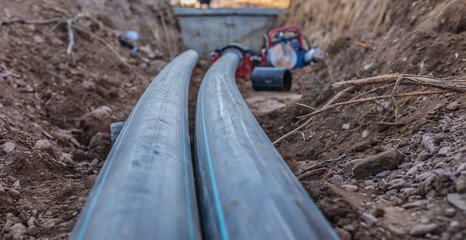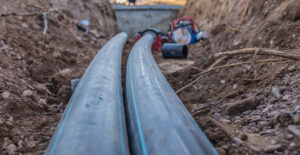An experienced excavation contractor does more than just move dirt. They carefully prepare construction sites by managing underground utilities, grading, and erosion control to ensure that projects have strong, lasting foundations.
These contractors also help build roads and coordinate with paving teams to create pavement that is durable and long-lasting. This work requires a wide range of expertise, including specialized equipment and strategic planning. Visit bartexcavationllc.com to learn more.
Before the construction process starts, an excavator contractor must survey and investigate a project site. This is necessary for determining whether the land is appropriate for construction and to locate any underground infrastructure that may interfere with building projects. This step also helps avoid unforeseen issues that can cause project delays or cost overruns.
Site preparation is a crucial process that involves clearing and grading the site, which prepares the ground for construction. This includes removing trees, brush, and other debris from the site using heavy machinery. It also involves grubbing, which is the removal of roots and stumps. Finally, grading is the process of leveling and shaping the site to ensure proper drainage and compliance with plans and regulations.
An excavation contractor is central to this process, as they are able to use the right equipment and implement best practices for sustainable construction. This includes selecting low-emission equipment, implementing erosion control measures, and protecting biodiversity. It also means ensuring that all construction waste is properly separated to avoid environmental harm and comply with local laws.
In addition to clearing and grading the site, excavating contractors are essential for laying foundations, digging trenches, and installing underground utilities. This is important for ensuring that the underlying soil can support a building’s weight and to prevent future structural problems. It’s also important to note that this work can be dangerous, so it’s crucial that your contractor is skilled and qualified.
If you’re planning a commercial construction project, it’s critical to hire the right excavation contractor to handle site preparation. A competent contractor will be able to finish the job quickly and efficiently, while meeting all environmental and legal requirements. They’ll also be able to identify potential challenges and make the necessary adjustments, which will save you money in the long run.
Integrating Vital Infrastructure
Many construction projects require the installation of vital infrastructure, such as sewage, electrical, and water systems. To do so, the infrastructure must be installed underground. Excavation contractors are responsible for digging trenches, laying pipes, and ensuring the underground systems are in working order. During this process, it’s important that the excavation contractor is aware of any existing services and avoids causing damage.
While it may seem like a straightforward job to complete, there are many factors to consider when choosing a qualified excavation contractor. For instance, a reputable excavation contractor will have a strong portfolio of work and will be able to provide references from past clients. This will help them stand out from other excavation contractors and ensure that they are the best fit for your specific project needs.
It’s also important to find an excavator that is familiar with your area. This will allow them to navigate any challenges that could come up during your project and save time. In addition, a local excavating contractor will be able to provide you with more accurate rates. In addition, their knowledge of your community will help them identify any potential problems that may arise during the project, such as zoning regulations or environmental concerns.
In some cases, a project requires the demolition of previous structures or the removal of vegetation that is interfering with its integrity. During these processes, it’s crucial that the excavation contractor has the right equipment for the task at hand. This includes a wide range of machinery like backhoes and bulldozers, as well as tools for clearing debris and stabilizing soil.
Another key aspect of excavation work is grading, or adjusting the terrain’s elevations to meet the required specifications in your construction plan. This process may involve leveling hills or filling valleys, achieving specific contours, or correcting drainage, which is essential for foundation stability and structural integrity.
One of the most challenging parts of this process is avoiding damaging existing utility lines, which can result in costly fines and repairs or even severe injury or death. According to Lyle, more than half of all damages are caused by failure to call 811. It’s important for excavation contractors and their employees to be aware of these rules and to use technology that enables them to locate underground objects quickly.
Erosion Control
When preparing construction sites, excavating contractors go far beyond just “moving dirt.” They are responsible for creating a stable foundation that supports the weight and structure of future buildings and infrastructure, managing underground utilities safely, and overseeing erosion control. By integrating these vital services and taking the time to carefully prepare sites, they ensure that projects are completed on schedule and without costly delays.
In many cases, the most effective way to control erosion is by planting vegetation. The roots of plants grip soil, holding it in place and preventing its movement. By contrast, soil exposed to heavy machinery is much more likely to move; this is why erosion control is such an important aspect of site preparation.
Keeping sediment off construction sites also reduces the risk of polluting water bodies and public right-of-way. Sediment control methods can include the use of silt fences, sediment basins, or other non-structural best management practices (BMP).
Erosion and sediment control must be monitored and maintained throughout the duration of a construction project. Regular inspections and maintenance must be undertaken to verify the effectiveness of BMPs, including the status of vegetation, sediment traps, or other best management practices. Often, it is possible to reduce erosion potential by scheduling construction activities during times when the risk of stormwater runoff is low.
Construction sites are typically required to prepare and submit an Erosion Prevention and Control Plan (ESC) before they can begin ground-disturbing activities. These plans identify the site’s existing topography, describe how it will be altered during construction, and detail the BMPs to be installed.
ESC plans must also contain details about the phasing of construction activities to minimize the length of time the site is exposed to erosion and sediment pollution. A good excavating contractor will be aware of the ESC requirements for their specific region and work with local environmental professionals to ensure compliance with all relevant laws. In addition, a reputable excavation company will use best practices to avoid disturbing wildlife habitats. This may include relocating fauna, establishing barriers, and scheduling work during breeding seasons.
Safety
Professional excavation contractors are accustomed to working in tight spaces and know how to manage risks like cave-ins. They follow strict safety protocols and use advanced equipment to minimize accidents. In addition, they are insured, which eliminates the financial risks associated with workplace accidents or damages to property during construction projects.
They are also experienced and knowledgeable when it comes to analyzing and discussing every detail of a site. This ensures that the worksite is safe and ready for construction to begin from day one. It’s not uncommon for unqualified contractors to make mistakes that could cost the project time and money, but reliable excavation contractors are trained to spot potential problems before they occur.
In fact, they are usually involved in project planning from the beginning to lend their insight and expertise on a safe path forward. For example, they can help figure out how to dig up dirt without tampering with electrical lines or water pipes that are running underneath.
Moreover, they are well-versed in the laws and regulations regarding environmental stewardship. They know how to prevent soil erosion, channel runoff water, and protect the groundwater supply, all while keeping costs low and ensuring a high-quality finished product.
It’s also important to note that excavation contractors are often responsible for constructing the foundation of buildings and infrastructure, so it makes sense that they have the knowledge and expertise to do it right. Unlike some other construction companies, excavation contractors don’t cut corners or use cheap materials. As such, they can guarantee a strong, stable building that will last for years to come.
Overall, excavating contractors are a vital part of any construction project. They provide the critical foundation that sets the stage for other construction activities and ultimately determines a project’s success. By leveraging their expertise and advanced machinery, they ensure that construction is done on schedule and without costly mistakes. Their services also save valuable time and resources by allowing other construction activities to proceed on schedule without delays or disruptions. This helps reduce overall project costs and improves project efficiency.


